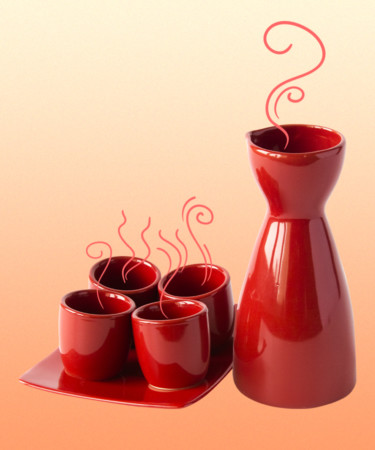Sake tends to be a hot and cold subject — either people could never imagine drinking a steaming cup of warmed sake, or they wouldn’t dare to pull a bottle straight from the fridge. Some even think that if a sake needs to be heated, then it is automatically low-quality. But according to Austin Power, owner of Accidental Bar in Manhattan’s East Village, that can’t be further from the truth.
In fact, Power says there is a whole range of temperatures to serve sake and different styles of sake that Western consumers haven’t yet experienced, and should. “There are multiple vocabulary words in Japanese that are specifically about the temperatures that sake should be served at,” he says. “The starting points are temperature and body temperature. Everything from there goes a good bit warmer and colder.”
The hottest temperature that sake should be served at is 140 degrees, according to Power. Sake can also be served at near-freezing temperatures, where it develops an almost slushy consistency. At Accidental Bar, Power serves his warm sake at a moderate 120 degrees so as not to overwhelm folks. “I’m from South Carolina and everything was too hot anyway, so I’ve never been much of a hot beverage drinker,” says Power. “But I think that the beauty of hot sake is you find really intense flavors when you warm them up.”
One of the biggest misconceptions about hot sake, Power says, is that heating it will intensify the alcohol. “Mostly what’s happening is that you had sake free one time in a mall, and they chose a sake that shouldn’t have been warm. Then, they put it in a microwave and all of the nuance was gone,” he says. But heating it well can lengthen the flavors of sake, almost like blowing up a balloon. A sake that is very umami-rich with earthy rice tones will expand as it warms, becoming softer, lighter, and more elegant.
Sakes that are served warm should have a highly expressive rice flavor, particularly those with a lower polishing or milling rate, around 60 to 70 percent. Some styles that Powers especially enjoys warming include unadulterated junmai, ginjos or daiginjos, or kimoto and yamahai styles that use open-barrel fermentation.
When serving sake at home, fight the urge to put anything in the microwave. Instead, boil a pot of water to the desired temperature, remove it from heat, and then bathe the whole sake bottle in the pot for a couple of minutes. In his bar, Powers uses a sous vide machine to control the temperature rather than a standard Japanese sake warmer because it allows him to more accurately control the temperatures. “[On the menu], I also have a couple of different sakes that I think are great at multiple temperatures,” he says. “For example, the Joyo Junmai 65. If you have it cold, it’s like a Martini with a twist. When you warm it up, it tastes really like dark cocoa — it’s such a drastic change between the two feelings, and they’re all excellent. “
Powers even thinks warm sake is the perfect beach drink — just hear him out. Take your ice-cold sake out of the cooler and dig it into the sand next to you. As the summer sun washes over the beach, the bottle will gradually warm as you lounge and sip, allowing you to experience a new temperature and flavor each time you refill your glass.
